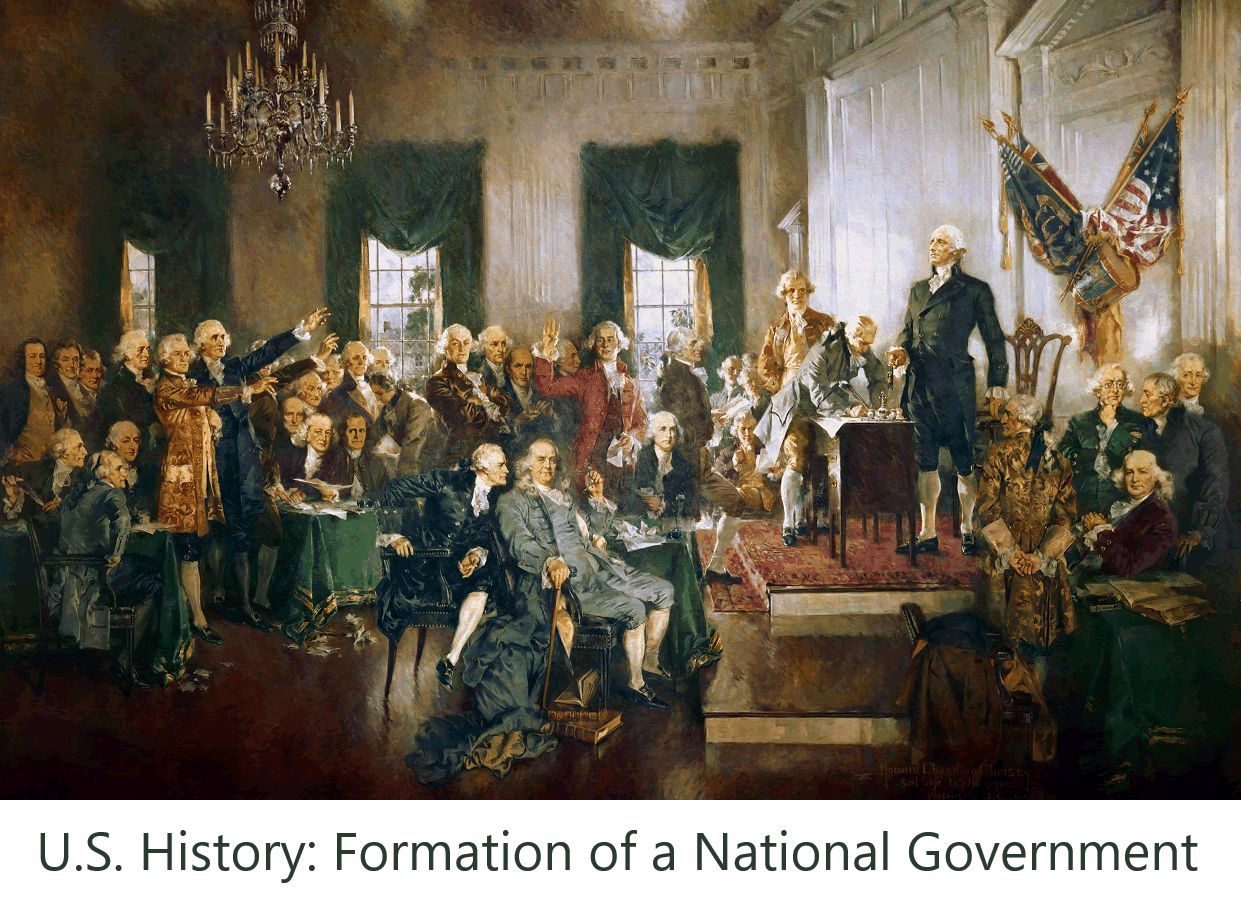Unit IV: Formation of a National Government |
|---|
| www.studenthandouts.com > U.S. History > Forming a National Government |
|
The founding of the United States government following the American Revolution was a complex and transformative process that culminated in the drafting and adoption of the U.S. Constitution. This period of nation-building involved significant debates, compromises, and the establishment of key institutions.
The Articles of Confederation (1777-1781): During the Revolutionary War, the Continental Congress adopted the Articles of Confederation in 1777 as the nation's first constitution. The Articles created a weak central government with limited powers. Each state retained significant sovereignty, making the federal government largely dependent on state cooperation. The central government had no power to tax, raise an army, or regulate trade effectively. It relied on voluntary contributions from the states.  Challenges and Weaknesses: The weaknesses of the Articles of Confederation became evident as the new nation faced economic instability, a lack of military resources, and difficulties in dealing with foreign nations. Challenges and Weaknesses: The weaknesses of the Articles of Confederation became evident as the new nation faced economic instability, a lack of military resources, and difficulties in dealing with foreign nations. Constitutional Convention (1787): In 1787, delegates from 12 of the 13 states (Rhode Island abstained) convened in Philadelphia for the Constitutional Convention. The goal was to revise the Articles of Confederation, but the convention ultimately decided to draft a new constitution. Key Founding Figures: Prominent figures at the Constitutional Convention included George Washington, who presided over the convention, and James Madison, often referred to as the "Father of the Constitution" for his influential role in shaping the document. The convention also included delegates with diverse backgrounds and viewpoints, leading to spirited debates and compromises. The Virginia Plan and the New Jersey Plan: Delegates proposed various plans for the new government. The Virginia Plan, put forth by James Madison, called for a strong central government with proportional representation in the legislature. The New Jersey Plan, presented by William Paterson, advocated for a unicameral legislature with equal representation for states. The Great Compromise: To resolve the dispute between large and small states, the Great Compromise, proposed by Roger Sherman, established a bicameral legislature. The House of Representatives would have representation based on a state's population, while the Senate would have equal representation for each state. Three-Fifths Compromise: Another contentious issue was the counting of enslaved individuals for representation and taxation. The Three-Fifths Compromise counted each enslaved person as three-fifths of a free person for these purposes. Ratification: The Constitution was signed on September 17, 1787, and sent to the states for ratification. A series of essays known as the Federalist Papers, written by Alexander Hamilton, James Madison, and John Jay, advocated for its adoption. Opposition to the Constitution led to the addition of the Bill of Rights, the first ten amendments to the Constitution, which protect individual liberties and rights. Ratification Process: The ratification process involved state conventions in each of the 13 states. Nine states needed to ratify the Constitution for it to take effect. It was a contentious process, with debates and compromises in many states. Establishment of the Federal Government: The U.S. government under the Constitution officially began on March 4, 1789. George Washington was unanimously elected as the first President of the United States, and the first Congress convened in New York City. The Bill of Rights (1791): The Bill of Rights, consisting of the first ten amendments to the Constitution, was ratified in 1791. These amendments protect individual freedoms, such as freedom of speech, religion, and the right to a fair trial. Early Government Institutions: The early federal government established key institutions, including the executive branch, the judiciary, and Congress. The Cabinet, consisting of advisors to the President, was formed to assist in governing. The founding of the United States government was a remarkable achievement in the history of political thought and governance. The Constitution, with its checks and balances, federal system, and protection of individual rights, laid the groundwork for the development of a stable and enduring democratic republic. It remains the supreme law of the land, serving as a model for constitutional democracies around the world. |
| UNIT I: | Early America | UNIT IX: | Discontent and Reform | ||
| UNIT II: | Colonial Period | UNIT X: | War, Prosperity, and Depression | ||
| UNIT III: | American Revolution | UNIT XI: | New Deal and World War II | ||
| UNIT IV: | New National Government | UNIT XII: | Postwar America | ||
| UNIT V: | Westward Expansion | UNIT XIII: | Decades of Change | ||
| UNIT VI: | Sectional Conflict | UNIT XIV: | New Conservatism | ||
| UNIT VII: | Civil War and Reconstruction | UNIT XV: | Into the Twenty-first Century | ||
| UNIT VIII: | Growth and Transformation | UNIT XVI: | Polarization and Deglobalization |
| www.studenthandouts.com > U.S. History > Forming a National Government |







